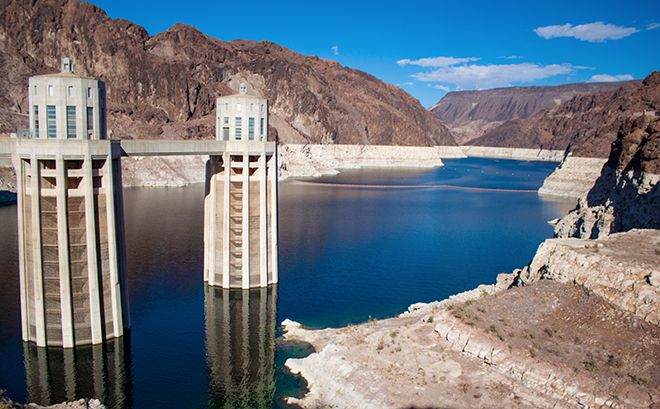S&P Global Offerings
Featured Topics
Featured Products
Events
S&P Global Offerings
Featured Topics
Featured Products
Events
S&P Global Offerings
Featured Topics
Featured Products
Events
Banking & Capital Markets
Economy & Finance
Energy Transition & Sustainability
Technology & Innovation
Podcasts & Newsletters
Banking & Capital Markets
Economy & Finance
Energy Transition & Sustainability
Technology & Innovation
Podcasts & Newsletters
S&P Global Offerings
Featured Topics
Featured Products
Events
22 Mar, 2022

|
Lake Mead, the largest reservoir in the U.S., is next to the 2,080-MW Hoover Dam in Nevada. |
A broad coalition of organizations filed a petition with the U.S. Environmental Protection Agency on March 21 seeking a rulemaking requiring hydropower facilities and reservoirs to report their greenhouse gas emissions.
"Regulators and policymakers often incorrectly assume and state that hydropower is a clean energy resource that emits zero carbon, when in fact some hydropower facilities emit massive amounts of [greenhouse gases]," the petition said.
Established in 2009, the EPA's Greenhouse Gas Reporting Program covers 41 source categories of planet-warming emissions such as carbon dioxide and methane. Although the reporting program was intended to expand over time, the EPA has not added any new source categories since 2010, the petition noted.
Meanwhile, the groups said a growing body of scientific research, including studies produced by EPA scientists, shows that hydroelectric dams and reservoirs are significant contributors to global greenhouse gas emissions.
"The EPA counts greenhouse gas emissions from more than 8,000 sites," Patagonia Inc. CEO Ryan Gellert said in a statement released by Earthjustice, an environmental law organization. "It doesn't make sense to exclude dams and reservoirs that are emitting methane, a greenhouse gas 25 times as potent as carbon dioxide."
Patagonia was one of 136 organizations to sign the March 21 petition.
Groups seek new source category
Hydroelectric dams and the reservoirs created to generate power can produce greenhouse gas emissions when organic materials and synthetic fertilizer runoff become trapped above spillways. Anaerobic decomposition creates methane and CO2 emissions as a byproduct. This process at some large dams and reservoirs can produce the same annual emissions as millions of gas-powered vehicles or even more than a fossil fuel-fired power plant with the same generation capacity, according to the petition.
Lake Mead, next to the Hoover Dam in Nevada, emits about 12.3 million metric tons of CO2 annually, or the annual equivalent of approximately 2 million gas-powered vehicles, the groups said, citing data from a 2016 study by Swiss scientists.
The Whitney Dam and Lake Whitney in Texas collectively emit about six times more CO2 than a coal-fired power plant producing the same amount of electricity, according to data from the same study.
The March 21 petition follows a Global Methane Pledge announced in November 2021 at the United Nations Climate Change Conference in Glasgow, Scotland. The voluntary pledge, signed by 105 countries and championed by the Biden administration, targets a 30% reduction in global emissions by 2030. Methane emissions have accounted for roughly 30% of global warming from preindustrial levels, according to the United Nations.
The petition noted that a related White House statement said methane pledge signatories committed to "moving towards using best available inventory methodologies to quantify methane emissions."
In the requested rulemaking, the petitioners asked the EPA to include dams, reservoirs, and "all other buildings, structures, stationary equipment, and plants located at the property that emit [greenhouse gases]" within a new source category.
The groups also suggested creating subcategories for hydroelectric and nonhydroelectric dams if different reporting thresholds or reporting requirements for those facilities are necessary.
"Requiring dams and reservoirs to report their [greenhouse gas] emissions will ensure that agencies and utilities have access to the best available information regarding hydropower's [greenhouse gas] emissions as they make decisions on the future of the electric sector, and not risk inadvertently pursuing a clean energy future that is not actually clean," the groups said.
Industry response
About 3% out of roughly 90,000 dams in the U.S. produce hydropower, according to the latest estimates from the U.S. Army Corps of Engineers.
"Of that 3%, only half of the hydro facilities have a reservoir," National Hydropower Association spokesperson LeRoy Coleman said in a March 22 email. "It's unfortunate that some organizations continue to peddle misinformation regarding hydropower and greenhouse gases."
Coleman cited data from the United Nations showing that U.S. stoves and refrigerators account for more than 100 times the life cycle greenhouse gas emissions produced by the nation's hydropower facilities.
The United Nations Intergovernmental Panel on Climate Change has also found that life cycle greenhouse gas emissions from hydropower facilities amount to less than half of those associated with solar generation, Coleman noted.
"Hydro is not a major [greenhouse gas] contributor," Coleman said. "The U.S. hydropower fleet is one of the cleanest sources of energy and essential to achieving a reliable, decarbonized grid."
An EPA spokesperson said the agency is reviewing the petition.
S&P Global Commodity Insights produces content for distribution on S&P Capital IQ Pro.
